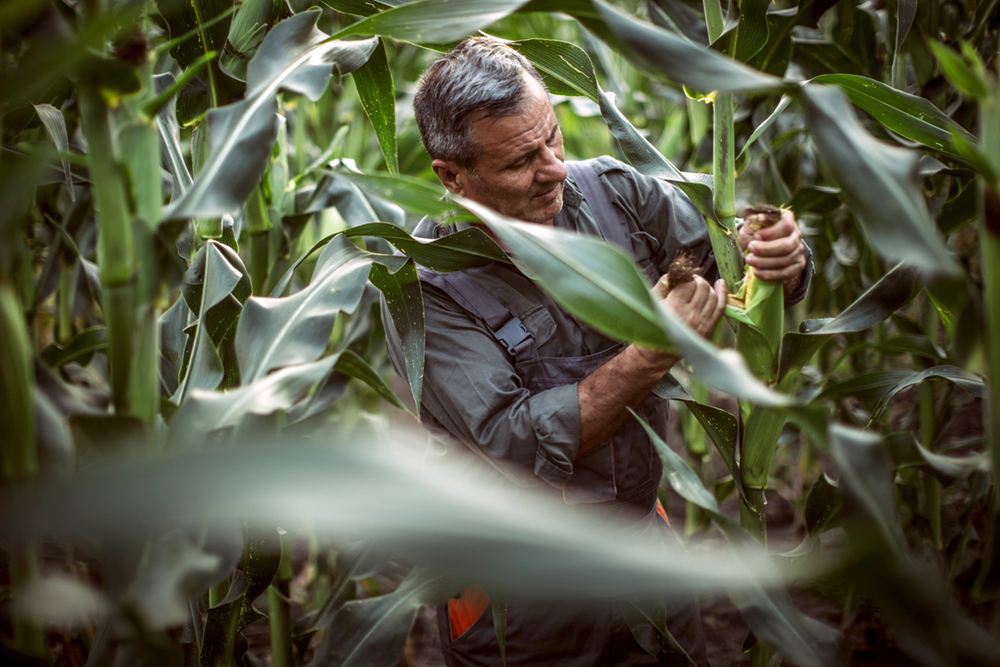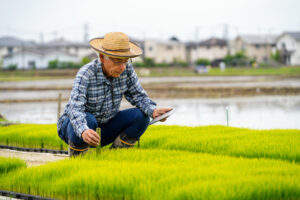Eliminating Food Insecurity Amid Growing Populations
Global population growth and increasing agricultural productivity are inextricably linked. According to the World Bank, Earth’s population in 1960 was 3 billion. Today, the population clock run by the United States Census says that the world’s population stands at 7.8 billion.
That dramatic upward climb has been accompanied—and made possible—by an increasingly productive agricultural industry. International agricultural productivity has risen at an annual rate of between 2% and 3% since the 1960s, according to the U.S. Department of Agriculture’s Economic Research Service. Some decades, such as the 1960s, saw especially robust growth (nearly 2.9% each year), while the 2010s were comparatively sluggish, at just over 2% annually.
The World Food Summit defines food security as being achieved when “all people, at all times, have physical and economic access to sufficient, safe and nutritious food that meets their dietary needs and food preferences for an active and healthy life.” Despite gains in productivity, food insecurity is on the rise.

Defined by the World Food Summit as the conditions under which “all people, at all times, have physical and economic access to sufficient, safe and nutritious food to meet their dietary needs and food preferences for an active and healthy life.”
The State of Food Security and Nutrition in the World 2021 report, compiled by the United Nations’ World Food Program, the Food and Agriculture Organization, the International Fund for Agricultural Development, the United Nations Children’s Fund and the World Health Organization, estimates that as many as 811 million people went hungry in 2020, due to extreme weather exacerbated by climate change and economic slowdowns worsened by COVID-19. The report also found that in 2020 about 12% of the world’s population experienced food insecurity, which is defined as running out of food or going an entire day without eating. Without specific solutions for food insecurity, the report found, 660 million people may face hunger in 2030—triple the current population of Brazil. Share on X
Lagging Productivity and Climate Extremes Increase Food Insecurity
What would it take to sustainably feed the world by 2050? Each year the Virginia Tech College of Agriculture and Sciences produces a global agricultural productivity report. In it, researchers calculate what is known as total factor productivity (TFP), which is a measure of the amount of crops, livestock and aquaculture products that can be produced using a constant or decreasing amount of land, labor, machinery, fertilizer and livestock. According to the report, global TFP growth was 1.36% between 2010 and 2019, but it needs to increase by 1.73% annually to keep up with the growing demand for food.
Not only is the world not meeting that mark, says the Virginia Tech research, but many nations that need to see their food production increase are actually experiencing a decline. Even where growth is taking place, it often comes through unsustainable practices, such as deforestation.
The difficulty, however, is more complex than just upping agricultural productivity—a steep obstacle itself. “If it was just about productivity, it would be challenging,” says Paul Winters, the Keough-Hesburgh Professor of Global Affairs at the University of Notre Dame’s Keough School of Global Affairs, who formerly served as director of the research and impact assessment division at the International Fund for Agricultural Development in Rome. “To me, the problems are other issues. One is climate change, and trying to increase productivity while simultaneously adapting to and mitigating the impact of agriculture on climate change.”
The impact is significant. According to the Intergovernmental Panel on Climate Change (IPCC), agriculture, forestry and land use are responsible for about 23% of total global greenhouse gas emissions, nearly the same amount as electricity and heat production combined. Already, the effects of climate change are sapping the capacity of farmers to produce crops and other goods. A recent study by Stanford University found that global farming productivity is 21% lower than it would be without the impact of climate change. That’s equivalent to losing seven full years of global agricultural increases since the 1960s.
Unprecedented Cooperation Needed to Alleviate Food Insecurity
Reducing and eventually eliminating global hunger and food insecurity is obviously a daunting challenge. The sheer scale of the task, says Mr. Winters, necessitates a concerted and collective effort that involves large and small farmers, development institutions, university researchers, big agriculture companies, and technology firms. That’s because the work and objectives of these different institutions and stakeholders are interdependent but have traditionally been siloed.

The number of people who went hungry in 2020.
Source: United Nations’ World Food Program and the World Health Organization
Solutions for food insecurity involve governments, nonprofits, and large agriculture and food companies delivering technologies and farming practices that are climate-friendly and more productive to the millions of small farmers around the world. According to a report by the U.N. Food and Agriculture Organization (FAO), there are 608 million family farms around the world, the vast majority of which manage less than 2 hectares of land. The FAO estimates that these small farms produce about 35% of the world’s food.
Many of these farmers grow only enough food to feed their families. Financial and technical support to help small farmers sustainably grow and sell more food can improve food security both by increasing the supply of food and by generating more income for the farmers themselves. One example of a collaborative effort to assist small farmers is in Ghana, where nonprofit Winrock International is working with The Hershey Company and Ecom Agroindustrial Corp. to improve the land management practices of cocoa farmers.
“The work is to demonstrate how improving land tenure, tree tenure and financing cocoa rehabilitation can improve yield, increase carbon stocks through shade trees and reduce deforestation,” says Aaron Sundsmo, Winrock’s senior director of agriculture, resilience and water. “As part of this work, Winrock is developing a payment-for- environmental-services scheme, where farmers receive payment from Hershey to maintain a certain level of shade on their farms and potentially increase tree cover off-farm.” These improved practices could become more widespread if farmers were to also receive payments for carbon sequestration for planting and maintaining shade trees.
Other organizations are also working to promote collaboration and partnerships that address food insecurity with climate-friendly agriculture practices. The World Bank’s Global Agriculture and Food Security Program (GAFSP) recently announced $150 million in grants to support low-income countries and farmers and strengthen more resilient and sustainable food systems.
Advocating for Better Policy and Regulation
Another cause of food insecurity arises when a country is overly reliant on food imports. Removing barriers to international agricultural trade is one way to help address this problem. Increasing national self-sufficiency is also critical—an effort that Winrock is supporting in Nepal.
“In recent years, several events—flooding, earthquakes, border closures—have illuminated the need to boost Nepal’s domestic rice production to reduce reliance on imported grain and unsustainable and inefficient practices,” Mr. Sundsmo says. In response, Winrock is working with the U.S. and Nepali governments as well as small farmers and private milling companies to initiate improved processing technologies and train farmers to produce healthy rice seedlings. In 2020, the collaboration improved rice yields for the participants to a level nearly 30% higher than the national average.
“Growers should get paid for sustainable farming or for reducing nitrogen, because that’s an economic risk.” —Adam Litle, CEO, Sound Agriculture
Improved technology, policy and regulations can also help farmers around the globe increase their production in more environmentally sustainable ways. For example, the Emeryville, California–based company Sound Agriculture is working to provide the nitrogen and phosphorus required by crops in ways that drastically reduce the use, cost and negative environmental impacts of traditional synthetic fertilizers. Over half of the nitrogen applied to corn, soy and other crops using synthetic fertilizers isn’t actually used by the plants. The nitrogen that isn’t absorbed flows into waterways and the atmosphere, causing significant environmental damage.
Sound Agriculture’s Source increases the nitrogen and phosphorous fixation of crops, while benefiting soil health, productivity and sustainability. “If you’re constantly dumping these synthetic fertilizers in your soil, the microbial activity goes down, your organic matter goes down, and the soil just loses its ability to have its robustness and resiliency,” says Adam Litle, the CEO of Sound Agriculture.
Mr. Litle argues that corporate executives should not only lobby for global solutions for food insecurity, but also in the U.S. For example, crop insurance provided by the federal government protects growers when weather and other events harm their yields. Mr. Litle argues that crop insurance and other incentives need updating to encourage farmers to change their practices to become more productive and climate-friendly over the long term. “Growers should get paid for sustainable farming or for reducing nitrogen, because that’s an economic risk,” he says.
Drive Innovation and Make It Widely Available
Continuous research and innovation are essential to addressing food insecurity, especially as climate extremes worsen. Mr. Winters points to groundbreaking research led by University of Chicago professor Chuan He, showing how RNA manipulation can increase crop yields by 50% and enable crops to better endure drought.
Solutions for food insecurity also include expanded use of technology as an avenue for improving agricultural production with fewer resources and emissions. Also known as smart or precision farming, this involves the deployment of sensors, drones, weather stations, robots and other technologies that collect data about conditions on a farm. That information can then be analyzed by artificial intelligence (AI) to guide decisions about when to plant, irrigate, fertilize or harvest crops.
Some agricultural innovation is even more radical. Indoor agriculture in greenhouses, warehouses and specially built shipping containers cultivates produce using a combination of electric lighting; heating, ventilation and air-conditioning equipment; building controls; automation; and, in some cases, AI. These farms require little or no soil and benefit from their highly controlled environment because they don’t need fertilizer and pesticides, aren’t impacted by droughts and storms, and require up to 95% less water than traditional outdoor farms. Time magazine recognized indoor farming company AeroFarms as one of its 100 Best Inventions of 2019, noting that its cultivation of greens is 390 times more productive per square foot than traditional agriculture.
“Innovation can bring increased productivity, more robust results and enhanced value to the global food chain,” says Insigniam consultant Bob Peterson. “However, innovators need to challenge their own inherent biases, beliefs and assumptions about the problem they are out to solve in order to produce a breakthrough in this incredibly complex challenge.”
Of course, there are big questions around who can access the sensors and other technologies that bolster outdoor farming, or make a shift to highly controlled indoor agriculture. “Having sensors in the field that allow for smart farming and place-based fertilizer, pesticide and water applications is a good thing. But who pays for it? And who collects and owns the data, and how does it get into the system when a lot of areas don’t have great internet or technology in place?” says John Fisk, who consults with nonprofit agriculture NGOs as CEO of Bluestem Food Systems.
Large corporations can make investments that expand the benefits of technology and innovation to farmers and consumers. But it requires patience and a willingness to rethink the entire supply chain. For example, the vast majority of U.S.-sourced fruits and vegetables are grown in California and Arizona, states that are increasingly challenged by severe drought. Shifting at least some production to wetter climates reduces financial risk and can benefit food production and security.
“When I think about solutions, I think about diversification,” Mr. Fisk says. “We need to diversify and move where resources are more predictable. Companies need to look at the long run about production and make investments in new areas that are good for them and the public. If we move salad greens to middle America and the East Coast where there is more water, what kind of investments are needed?”
Though clear-eyed about the challenges of ending food insecurity, Mr. Fisk is encouraged by how many big companies see their own future growth tied to increasing production through sustainable practices. “Conventional agriculture is embracing climate change and embracing solutions to it,” he says. “It’s never about these companies and industries doing things for altruism. But they are starting to see their future through that prism.”

This article appeared in the Winter 2022 issue of Insigniam Quarterly with the headline “Increasing Food Production for Growing Populations.” To begin receiving IQ, go here.



